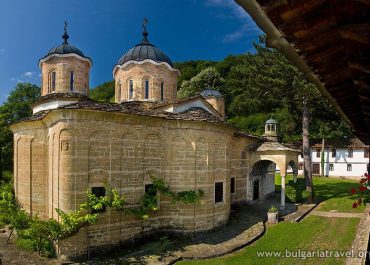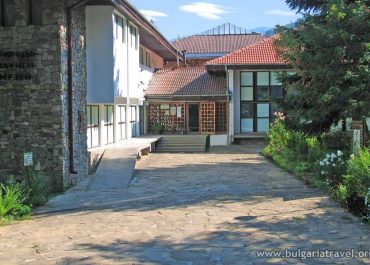
Sopot
Sopot is situated at a distance of only 5 km from Karlovo, about 130 km from Sofia, and 64 from Plovdiv. The small town is situated in the north part of the Karlovo valley, at the foot of the central part of the Balkan Mountain Range.
Sopot is an old Bulgarian settlement, established in the 14th century. The fortress walls of the Medieval Bulgarian fortress of Anevsko Kale are situated at a distance of 2 km north-west from Sopot. This is a part of the Medieval town of Kopsis, which was prospering during the 13th – 14th centuries.
Sopot is one of the centers of Bulgarian revival. The Revival legacy of the population is related to craftsmanship – wool making, wool spinning, homespun tailoring (manufacturing of rough woolen fabric), tailoring (cloths making), milling, etc. The first bottle making and glass factory on the Balkan Peninsula was established here. Rose production was also well developed here.
Sopot is one of the centers of the national liberation struggles. The Patriarch of Bulgarian Literature – the writer Ivan Vazov (1850 – 1921) was born here and his personality was shaped here.
The native house of the great Bulgarian writer Ivan Vazov is situated in the center of the town of Sopot, on 1 Vasil Levski Str. It is one of the 100 National Tourist Sites. The house was built in the 18th century by the grandfather of the writer, but the original building was set on fire in July 1877 during the Liberation War between Russia and Turkey (1877 – 1878). In 1920 a decision was made to restore his native home and establishment of a museum inside it. The director of the Sofia Ethnographic Museum made an almost authentic restoration of the house by relying on memories of the brothers and the sister of Vazov, as well as on some of his literary works and mostly the novel Pod Igoto (Under the Yoke), the short novels Chichovtsi (Uncles) and some short stories. The museum was open on 6 June 1935. Many personal belongings of the writer and his family as well as rugs made by Vazov’s mother – Saba Vazova are preserved in the museum.
A few buildings are housed in the yard. They accommodate various expositions. A restoration with dummies of the barber’s shop of Hadzhi Ahil of the Vazov’s short story with the same name is organized in one of the rooms. A water channel that is very typical for the Sopot streets and yards passes through the cobblestone yard decorated with and flowers. A small door leads to a neighboring yard, where the exposition hall dedicated to the life and the artistic path of the author is situated.
Other interesting buildings in Sopot from the period of Revival (18th – 19th) century are the Frateva House, Shosheva House, Badina House, Hadzhi Manchova House, and the Tumbalieva House.
Another landmark of the town is the Girls’ Convent “Blessed Virgin”, which is situated in the central part of the town of Sopot. The church “St. Peter and Paul” is situated meters from the convent. It impresses the visitors with its original architecture which was made by builders from Bratsigovo in 1846. Another interesting temple is the church “St. Apostles Peter and Paul” – an impressive pseudo basilica with a nave and two isles. Is keeps a modest iconostasis with two rows of icons. Faded traces of wall paintings can be seen on the walls. A few very precious old icons are kept in the temple.
The Sopot monastery “St. Spas” is situated at a distance of about a kilometer from the town, at the foot of the mountain. It was established in the 18th century and is still active. No catering and accommodation are offered there, but the meadow in front of it, also known as the Monastery Meadow, often becomes a host of gathering and traditional events. In the middle of February, the traditional gathering entitled “Let’s warm our hearts with wine and love”, by which the day of the vine-grower Trifon Zarezan is celebrated there.
Sopot is a town of rich cultural traditions – concerts, celebrations, and exhibitions such as the Days of Vazov, the culmination of which is 9 July – the birth date of the poet, are conducted here every year.
The tourism possibilities in the town are numerous. It attracts a large number of Bulgarians and foreigners by its preserved appearance, traditions and culture from the period of the Revival. The town and the beautiful nature around it are aiding the place in becoming a preferred area for paragliding and mountain cycling. Every year Sopot is a host of national and international contests of paragliding in multiple disciplines.
There are multiple huts in the region of Sopot, which you can reach by the marked paths. One of them is the Nezabravka hut (at a distance of 3 hours). Various tourist routes start from it. You can head to the Levski peak (2 hours), Ambaritsa hut (3 hours) and Dermenka hut (3 hours).
The accommodation in Sopot is diverse – hotels, guest houses, huts, etc. The catering and entertainment establishments offer dishes made by local traditional recipes.
Monday – Saturday
09:00 – 18:00
Sunday
09:00 – 17:00
In the Museum House of Ivan Vazov tour guides offer guided tours and lectures in Bulgarian language.
Tourist Information Center – Plovdiv
Monday – Sunday
9:00 – 22:00 /summer working time/
9:00 – 20:00 /winter working time/
1, Rayko Daskalov Str. /Roman stadium sq./
Tel: +359 32 620 229
E-mail: tourism@plovdiv.bg
Website: visitplovdiv.com
4330 Sopot, region Plovdiv, 1 Vasil Levski Str
Tel:
Museum Information +359 878 672 458
Requests for visits +359 878 694 734
E-mail: vazovmuseum_sopot@abv.bg
Website: http://vazovmuseum.com/
Sopot is situated at a distance of only 5 km from Karlovo, about 130 km from Sofia, and 64 from Plovdiv. The small town is situated in the north part of the Karlovo valley, at the foot of the central part of the Balkan Mountain Range.
Sopot is an old Bulgarian settlement, established in the 14th century. The fortress walls of the Medieval Bulgarian fortress of Anevsko Kale are situated at a distance of 2 km north-west from Sopot. This is a part of the Medieval town of Kopsis, which was prospering during the 13th – 14th centuries.
Sopot is one of the centers of Bulgarian revival. The Revival legacy of the population is related to craftsmanship – wool making, wool spinning, homespun tailoring (manufacturing of rough woolen fabric), tailoring (cloths making), milling, etc. The first bottle making and glass factory on the Balkan Peninsula was established here. Rose production was also well developed here.
Sopot is one of the centers of the national liberation struggles. The Patriarch of Bulgarian Literature – the writer Ivan Vazov (1850 – 1921) was born here and his personality was shaped here.
The native house of the great Bulgarian writer Ivan Vazov is situated in the center of the town of Sopot, on 1 Vasil Levski Str. It is one of the 100 National Tourist Sites. The house was built in the 18th century by the grandfather of the writer, but the original building was set on fire in July 1877 during the Liberation War between Russia and Turkey (1877 – 1878). In 1920 a decision was made to restore his native home and establishment of a museum inside it. The director of the Sofia Ethnographic Museum made an almost authentic restoration of the house by relying on memories of the brothers and the sister of Vazov, as well as on some of his literary works and mostly the novel Pod Igoto (Under the Yoke), the short novels Chichovtsi (Uncles) and some short stories. The museum was open on 6 June 1935. Many personal belongings of the writer and his family as well as rugs made by Vazov’s mother – Saba Vazova are preserved in the museum.
A few buildings are housed in the yard. They accommodate various expositions. A restoration with dummies of the barber’s shop of Hadzhi Ahil of the Vazov’s short story with the same name is organized in one of the rooms. A water channel that is very typical for the Sopot streets and yards passes through the cobblestone yard decorated with and flowers. A small door leads to a neighboring yard, where the exposition hall dedicated to the life and the artistic path of the author is situated.
Other interesting buildings in Sopot from the period of Revival (18th – 19th) century are the Frateva House, Shosheva House, Badina House, Hadzhi Manchova House, and the Tumbalieva House.
Another landmark of the town is the Girls’ Convent “Blessed Virgin”, which is situated in the central part of the town of Sopot. The church “St. Peter and Paul” is situated meters from the convent. It impresses the visitors with its original architecture which was made by builders from Bratsigovo in 1846. Another interesting temple is the church “St. Apostles Peter and Paul” – an impressive pseudo basilica with a nave and two isles. Is keeps a modest iconostasis with two rows of icons. Faded traces of wall paintings can be seen on the walls. A few very precious old icons are kept in the temple.
The Sopot monastery “St. Spas” is situated at a distance of about a kilometer from the town, at the foot of the mountain. It was established in the 18th century and is still active. No catering and accommodation are offered there, but the meadow in front of it, also known as the Monastery Meadow, often becomes a host of gathering and traditional events. In the middle of February, the traditional gathering entitled “Let’s warm our hearts with wine and love”, by which the day of the vine-grower Trifon Zarezan is celebrated there.
Sopot is a town of rich cultural traditions – concerts, celebrations, and exhibitions such as the Days of Vazov, the culmination of which is 9 July – the birth date of the poet, are conducted here every year.
The tourism possibilities in the town are numerous. It attracts a large number of Bulgarians and foreigners by its preserved appearance, traditions and culture from the period of the Revival. The town and the beautiful nature around it are aiding the place in becoming a preferred area for paragliding and mountain cycling. Every year Sopot is a host of national and international contests of paragliding in multiple disciplines.
There are multiple huts in the region of Sopot, which you can reach by the marked paths. One of them is the Nezabravka hut (at a distance of 3 hours). Various tourist routes start from it. You can head to the Levski peak (2 hours), Ambaritsa hut (3 hours) and Dermenka hut (3 hours).
The accommodation in Sopot is diverse – hotels, guest houses, huts, etc. The catering and entertainment establishments offer dishes made by local traditional recipes.
Monday – Saturday
09:00 – 18:00
Sunday
09:00 – 17:00
In the Museum House of Ivan Vazov tour guides offer guided tours and lectures in Bulgarian language.
Tourist Information Center – Plovdiv
Monday – Sunday
9:00 – 22:00 /summer working time/
9:00 – 20:00 /winter working time/
1, Rayko Daskalov Str. /Roman stadium sq./
Tel: +359 32 620 229
E-mail: tourism@plovdiv.bg
Website: visitplovdiv.com
4330 Sopot, region Plovdiv, 1 Vasil Levski Str
Tel:
Museum Information +359 878 672 458
Requests for visits +359 878 694 734
E-mail: vazovmuseum_sopot@abv.bg
Website: http://vazovmuseum.com/
Virtual map
Photos
© All images, advertising and video materials and/or other information published on this website are property of the Ministry of Tourism and are protected by the Law on Copyright and Related Rights, according to the Bulgarian laws to all applicable international and relevant acts of the European Union.





